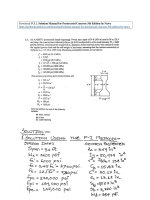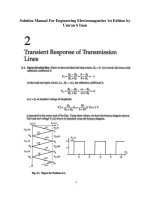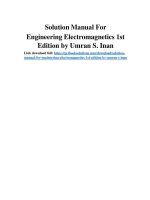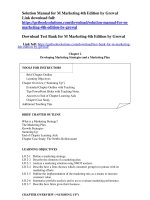Solution manual for understanding business 11th edition by nickels
Bạn đang xem bản rút gọn của tài liệu. Xem và tải ngay bản đầy đủ của tài liệu tại đây (1.38 MB, 236 trang )
Chapter 01
Solution Manual for Understanding Business 11th Edition by
Nickels
Link download full: />
True / False Questions
1.
Businesses provide goods, jobs, and services to others.
True
2.
Businesses seek to earn a profit by providing goods and services to others.
True
3.
False
False
Revenue is the amount a business earns above and beyond what it spends for expenses and
costs.
True
4.
False
Profit is the amount of money a business earns above and beyond what it spends for salaries and
other expenses.
True
5.
Since all businesses make a profit, starting a business is not risky.
True
6.
False
False
An entrepreneur risks time and money to start and manage a business.
True
False
1-1
Copyright © 2016 McGraw-Hill Education. All rights reserved. No reproduction or distribution without the prior written consent of
McGraw-Hill Education.
7.
If a business's costs and expenses are greater than its revenue, it will suffer a loss.
True
8.
Profits of a business include the salaries paid to its employees.
True
9.
False
False
Revenue is the total amount of money a business takes in during a given period by selling goods
and services.
True
False
10. Risk is the chance an entrepreneur takes of losing time and money on a business that may not
prove profitable.
True
False
11. The United States has one of the highest standards of living in the world.
True
False
12. The term "standard of living" refers to the amount of debt people can incur on a given income.
True
False
13. Health care availability, a clean environment, and good schools all contribute to a high quality of
life.
True
False
14. Maintaining a high quality of life requires the combined efforts of businesses, nonprofit
organizations, and government agencies.
True
False
1-2
Copyright © 2016 McGraw-Hill Education. All rights reserved. No reproduction or distribution without the prior written consent of
McGraw-Hill Education.
15. Stakeholders are all the people who stand to gain or lose by the policies and activities of a
business.
True
False
16. Stakeholders include customers, employees, stockholders, suppliers, dealers, bankers, government
officials and environmentalists.
True
False
17. Outsourcing means selling goods and services to people in other countries.
True
False
18. Outsourcing has caused many complications in many states where jobs have been lost to overseas
companies.
True
False
19. Insourcing refers to the practice of global companies setting up design and production facilities in
the United States.
True
False
20. The knowledge and skills learned in business courses are seldom relevant to students who work for
nonprofit organizations or volunteer groups.
True
False
21. Businesses and nonprofit organizations often strive to accomplish the same objectives.
True
False
22. Nonprofit organizations use financial gains to meet stated social or educational goals of the
organization rather than personal profit.
True
False
1-3
Copyright © 2016 McGraw-Hill Education. All rights reserved. No reproduction or distribution without the prior written consent of
McGraw-Hill Education.
23. Social entrepreneurs are people who start and manage organizations that are not-for-profit. Their
mission is to help others improve their quality of life.
True
False
24. The only real purpose of a business is to make money for entrepreneurs.
True
False
25. The only way a firm can increase its profits is to increase its sales revenue.
True
False
26. The amount of profit or loss earned by a business can be found by subtracting the firm's expenses
from its revenues.
True
False
27. Nonprofit organizations are similar to businesses in that they often provide goods and services
that satisfy the needs of society.
True
False
28. Unlike businesses, employees of nonprofit organizations are not required to learn the business
skills of information management, marketing, or financial management.
True
False
29. Business decisions should consider the interests of customers, employees, suppliers, government
leaders, and stockholders.
True
False
30. By balancing the demands of customers and stockholders, businesses satisfy the demands of all
stakeholders.
True
False
1-4
Copyright © 2016 McGraw-Hill Education. All rights reserved. No reproduction or distribution without the prior written consent of
McGraw-Hill Education.
31. An effort to please one group of stakeholders eventually pleases all stakeholders.
True
False
32. Insourcing creates new jobs, and helps offset the number of jobs being outsourced.
True
False
33. Robin has started her own online consulting firm. While she recognizes the risks involved in
operating a business, she is still willing to invest her time, effort, and money in hopes of earning a
profit. Robin is an example of an entrepreneur.
True
False
34. Backstreet Books, an eclectic bookstore on a large college campus, generated total revenues of
$15 million while incurring expenses of $12 million. During the year Backstreet Books earned a
profit of $3 million.
True
False
35. Since businesses strive to earn a profit, their owners benefit at the expense of the rest of society.
True
False
36. John earned the same amount of money this year as he did last year. Thus, his standard of living
must be the same as it was last year.
True
False
37. Susan quit her job in a big city to take a less stressful position in a small town located in a scenic
area. She earns less money at her new job and has had to cut back on her purchases of material
goods, but she has more leisure time and really enjoys the clean air and scenic beauty of her new
home. Susan has accepted a lower standard of living in order to enjoy a higher quality of life.
True
False
1-5
Copyright © 2016 McGraw-Hill Education. All rights reserved. No reproduction or distribution without the prior written consent of
McGraw-Hill Education.
38. Political freedom, quality education, access to health care, and a clean environment are all factors
that contribute to an improved quality of life.
True
False
39. People living in San Jose, CA, on average earn more money than people living in St. Louis, MO.
The citizens of San Jose enjoy a higher standard of living than the citizens of St. Louis.
True
False
40. The major difference between businesses and nonprofit organizations is that only businesses can
increase the standard of living, while only nonprofit organizations can improve the quality of life.
True
False
41. A charitable organization, such as the American Red Cross or Salvation Army, is classified as a forprofit organization.
True
False
42. It was reported by a Beijing newspaper that China succeeded in improving its people's standard of
living and establishing a relatively affluent society recently. This report clearly indicates that both
income levels and the price of goods and services rose significantly during that time period.
True
False
43. Starting a business is a riskier path toward business success than working your way up the ranks of
a large business.
True
False
44. Working as an entrepreneur is the only way to succeed in business.
True
False
1-6
Copyright © 2016 McGraw-Hill Education. All rights reserved. No reproduction or distribution without the prior written consent of
McGraw-Hill Education.
45. Paid vacations and health care insurance are among the benefits provided by the government to
entrepreneurs.
True
False
46. Women currently own less than 10 percent of all businesses.
True
False
47. The number of businesses owned by Asian Americans Hispanic Americans, and Native Americans
has grown dramatically.
True
False
48. Land, sometimes called natural resources, is the most critical factor of production in explaining why
some countries are poor while others are rich.
True
False
49. Money is one of the five factors of production that contribute to the creation of wealth.
True
False
50. Tools, machinery, and buildings are examples of capital resources.
True
False
51. The major advantage rich nations have over poor nations is an abundance of land and labor.
True
False
52. Entrepreneurship is one of the five factors of production that contribute to the creation of wealth.
True
False
1-7
Copyright © 2016 McGraw-Hill Education. All rights reserved. No reproduction or distribution without the prior written consent of
McGraw-Hill Education.
53. Business consultant Peter Drucker said that the most important factor of production is knowledge.
True
False
54. Most business experts agree that entrepreneurship and the effective use of knowledge are the
most important contributors to the creation of wealth.
True
False
55. The business environment refers to the surrounding factors that either help or hinder the
development of businesses.
True
False
56. Sarah is a recent U.S. college graduate who is interested in starting an import tea business. If she
follows through with her plans, she will be a pioneer, because only a handful of women choose to
start businesses in the U.S.
True
False
57. Countries with an inadequately trained work force and few entrepreneurs often achieve the
highest levels of income by relying on a large number of workers.
True
False
58. If they wish to create more wealth, poor nations should focus on policies that increase
entrepreneurship and the effective use of knowledge.
True
False
59. To realize his passion, Alex recently opened Original Tunes, Inc., a small state-of-the-art recording
studio in Nashville, TN. He probably could have set up shop in several major cities, but Nashville
offered him the two most important factors that he learned in business school would enhance the
creation of wealth: labor and political freedom.
True
False
1-8
Copyright © 2016 McGraw-Hill Education. All rights reserved. No reproduction or distribution without the prior written consent of
McGraw-Hill Education.
60. Greg recently completed his degree in construction management and is planning to start a
business developing apartment buildings. After researching several potential areas, he chose
Mexico City due to its high population. Greg felt that this factor would create a large labor pool,
the most important of the five factors of production.
True
False
61. Jarett is supposed to be cramming for finals but his mind keeps wandering to the Colorado slopes.
Several years ago, his Uncle Mike made it big and now owns a ski lodge just north of Aspen. He
promised Jarett a management trainee position and the opportunity to buy into the company by
contributing a portion of his paycheck each month back into the business. As he dreams about the
opportunity to be his own boss, reality bites as Jarett scans his business book and reads, "freedom
to succeed also means freedom to fail."
True
False
62. Taxes and government regulations are part of the economic and legal environment in which
businesses operate.
True
False
63. High taxes and government restrictions help to encourage entrepreneurs by providing greater
incentives for people to work hard and create profit.
True
False
64. One of the best things the governments of developing countries can do to increase wealth is to
minimize interference with the free exchange of goods and services.
True
False
65. In countries where businesses cannot enter into binding contracts, business owners assume
additional risk.
True
False
1-9
Copyright © 2016 McGraw-Hill Education. All rights reserved. No reproduction or distribution without the prior written consent of
McGraw-Hill Education.
66. In an effort to increase wealth and their country's standard of living, many governments are taking
over major industries and operating them as nonprofit organizations.
True
False
67. Corruption and illegal activities are expected in a capitalist system and can be beneficial.
True
False
68. One way for a government to actively promote entrepreneurship is to establish a currency that's
tradable in world markets so that you can buy and sell goods anywhere in the world using that
currency.
True
False
69. Honesty, integrity, and high ethical standards are essential to a capitalist economic system like the
one that operates in the United States.
True
False
70. Laws that allow companies to write enforceable contracts decrease the risk of doing business.
True
False
71. In rich countries such as the United States, changes in the level of taxation have little impact on the
incentives of entrepreneurs.
True
False
72. The failure to uphold high ethical business standards by a few companies can negatively impact
the entire U.S. business community.
True
False
1-10
Copyright © 2016 McGraw-Hill Education. All rights reserved. No reproduction or distribution without the prior written consent of
McGraw-Hill Education.
73. Several years ago, the government of the small nation of Allegro owned the nation's telephone
company and landlines. This relatively poor government relied on taxes to develop this industry
and provide service to its citizens. If the government desired to rapidly improve people's access to
phone service, its best course of action would involve selling the telephone company to private
investors.
True
False
74. The government of the nation of Winstone is trying to achieve a high quality of life by imposing
strict regulations to protect the environment and ensure safe working conditions in factories and
mines. The government also has established ambitious programs to help the poor, financing them
by setting high tax rates. These efforts by Winstone's government should create an atmosphere
that encourages entrepreneurship.
True
False
75. Though it has received a lot of attention, the development of the Internet has had less of an
impact on the way businesses operate than many other technological changes.
True
False
76. An increase in productivity indicates that more can be produced in a given time period with the
same amount of resources.
True
False
77. Technology can help businesses become more efficient and productive.
True
False
78. Productivity is the amount of output you generate given the amount of input such as hours
worked.
True
False
1-11
Copyright © 2016 McGraw-Hill Education. All rights reserved. No reproduction or distribution without the prior written consent of
McGraw-Hill Education.
79. Effectiveness means producing goods and services using the least amount of resources.
True
False
80. Effectiveness means producing the desired result.
True
False
81. Technology refers to everything that makes business operations more effective, efficient, and
productive.
True
False
82. E-commerce is the buying and selling of goods over the Internet.
True
False
83. The B2B Internet market consists of selling goods and services to consumers.
True
False
84. The rise of Internet marketing has become particularly important in doing business in the B2B
markets.
True
False
85. The business-to-business segment of e-commerce is of less importance than the business-toconsumer segment of e-commerce.
True
False
86. Technology allows firms to be more responsive to their customers' wants and needs.
True
False
1-12
Copyright © 2016 McGraw-Hill Education. All rights reserved. No reproduction or distribution without the prior written consent of
McGraw-Hill Education.
87. Bar codes are a form of technology that has enhanced a company's ability to be responsive to
consumer needs.
True
False
88. An electronic storage file where information is kept is called a CPU.
True
False
89. The databases of a business often include a great deal of information about the firm's customers.
True
False
90. Information in a database allows firms to carry only the products that the local population wants.
True
False
91. Identity theft is when individuals or firms access people's personal information and then use it for
illegal purposes and activities.
True
False
92. The main difference between B2C and B2B e-commerce is that B2C uses only the Internet, while
B2B combines e-commerce with traditional (bricks-and-mortar) outlets.
True
False
93. There is less risk involved in starting an e-commerce-only business than there is in trying to add ecommerce to a traditional (bricks-and-mortar) store.
True
False
94. One of the major advantages to firms involved in e-commerce is that the technology is still so new
that the Internet-based firms face very little competition.
True
False
1-13
Copyright © 2016 McGraw-Hill Education. All rights reserved. No reproduction or distribution without the prior written consent of
McGraw-Hill Education.
95. Nicki has joined with several other investors to form a new company that sells foot-care products
to consumers over the Internet. Nicki has invested in a B2C e-commerce company.
True
False
96. Over the past several years, workers in the small nation of Rainland have enjoyed an increase in
the number of holidays and a reduction in the average length of the workday that have reduced
the total number of hours they work each year. However, the output per worker in Rainland is
higher now than it was before the reduction in hours. These facts suggest that productivity in
Rainland has increased.
True
False
97. SleekWrap is a company that produces industrial coatings for the steel industry. Until recently it
relied on wholesalers to distribute its products to other businesses, but now it also sells directly to
its business customers through its website. This is an example of the largest and most important
type of e-commerce transaction.
True
False
98. As emerging technologies become widespread, businesses tend to find better uses for them.
However, in the case of the Internet, businesses that sell B2B have not benefited from directly
selling to their business customers in the same way that B2C companies have done.
True
False
99. With the emergence of the Internet, Jasmine finds it easy to do all her gift buying online. She takes
comfort in the fact that new technologies if installed properly are seldom used in unethical ways.
True
False
100. Technological innovation has a ripple effect. With the advent of the Internet, Tyler, a certified technerd, is being courted by companies to write the next generation of antivirus software. He tells us
its big business!
True
False
1-14
Copyright © 2016 McGraw-Hill Education. All rights reserved. No reproduction or distribution without the prior written consent of
McGraw-Hill Education.
101. To remain competitive in today's market, firms must produce a quality product and offer
outstanding service at a reasonable price.
True
False
102. Producing a high-quality product will ensure success in the competitive environment.
True
False
103. Successful firms follow a customer-driven strategy, as opposed to the management-driven
strategy used in the past.
True
False
104. Zero defects means that there is a company goal of no mistakes in making products.
True
False
105. Traditional businesses have a managerial focus rather than a customer focus.
True
False
106. Competition is fierce! One way to respond quickly to customer needs is to develop a strategy of
empowering employees.
True
False
107. A policy of empowerment encourages managers to make decisions quickly for their frontline
employees.
True
False
108. Empowerment means giving frontline workers the responsibility, authority, and freedom to
respond quickly to customer requests.
True
False
1-15
Copyright © 2016 McGraw-Hill Education. All rights reserved. No reproduction or distribution without the prior written consent of
McGraw-Hill Education.
109. The goal of empowerment in the workplace is to prevent mistakes. Therefore, giving management
more control over the actions of lower-level workers will prevent mistakes.
True
False
110. The primary focus of successful firms is designing and producing high-quality goods. Advertising is
then used to convince consumers to buy their superior products.
True
False
111. It's important that firms are as efficient as possible. This is done by becoming management-driven
for efficiency.
True
False
112. Customer-driven organizations require managers to closely direct and control their employees.
True
False
113. Bruno and Gino are worthy competitors in the bakery business in a small upscale resort town. Gino
recently negotiated a contract with a supplier for really cheap cooking oil. He knows that bakery
customers want cheap products. In this competitive environment, keeping the price down is all
that matters.
True
False
114. Brett runs a lawn-care service. Although he and his employees could service eight households in
one day, he averages six yards per crew member, per day. Brett recently restructured his work
crew and provided each cutter with an incentive to acquire two new customers each month
through customer referrals. As a recent business graduate, you tell him he's probably on the right
track.
True
False
1-16
Copyright © 2016 McGraw-Hill Education. All rights reserved. No reproduction or distribution without the prior written consent of
McGraw-Hill Education.
115. The statistical study of the human population to describe its size, age, gender, and income is
known as diversity recognition.
True
False
116. The U.S. population tends to buy the same things and spend time in roughly the same way as
people did a decade ago.
True
False
117. Demographic changes create new business opportunities.
True
False
118. Diversity groups identified in the market today can include extroverts, introverts, atheists, and the
devout.
True
False
119. Companies have responded to a diverse customer base by hiring a more diverse workforce.
True
False
120. Currently people between the ages of 45 and 54 are the richest group in the United States.
True
False
121. New welfare rules have made it easier for single parents to remain at home with their young
children without being required to seek employment.
True
False
122. In some cities the number of legal and illegal immigrants has caused governments to adapt by
changing signs to other languages.
True
False
1-17
Copyright © 2016 McGraw-Hill Education. All rights reserved. No reproduction or distribution without the prior written consent of
McGraw-Hill Education.
123. The federal government requires companies to take diversity very seriously, even recommending
establishing a chief diversity officer in the executive suite.
True
False
124. One factor that has had a major effect on businesses is the growth of single-parent families.
True
False
125. Businesses that cater to older consumers in the future will likely not be successful.
True
False
126. Businesses use demographic studies to understand where people live, their lifestyles, and what
they are likely to buy.
True
False
127. Diversity management would not be an issue if firms would treat all of their employees the same.
True
False
128. Demographic trends suggest that businesses will benefit from offering flexible work schedules,
elder care, and child care to help employees balance the demands of job and family.
True
False
129. The current Social Security system will ensure that the young people of today will have Social
Security benefits in the future when they retire.
True
False
1-18
Copyright © 2016 McGraw-Hill Education. All rights reserved. No reproduction or distribution without the prior written consent of
McGraw-Hill Education.
130. Xavier, a recent college graduate, is thinking of investing in a home health care business. He
believes this will be a profitable venture because of the increasing number of people in the U.S.
that will be over 60 in the near future and more likely to need this type of service. This accurately
describes a demographic trend that will affect his business choice.
True
False
131. Sue is a single mother with two small children. Her employer is considering providing family leave.
Since Sue is a single mom with small children, she is unlikely to benefit from this program.
True
False
132. Rob is an emergency room nurse at a local hospital in Texas. On a weekly basis, he will serve a
number of patients who are not legally U.S. citizens. Many of them are giving birth to babies.
Fortunately, Rob speaks enough Spanish to communicate with the patients. Rob is experiencing
the realities of the social environment in some states.
True
False
133. Globalization has increased among nations.
True
False
134. An important environmental change in the global environment is the growth of international
competition.
True
False
135. Improved distribution systems have led to more global trade.
True
False
136. Global trade has suffered because of increased problems with the Internet.
True
False
1-19
Copyright © 2016 McGraw-Hill Education. All rights reserved. No reproduction or distribution without the prior written consent of
McGraw-Hill Education.
137. Globalization has greatly increased living standards around the world.
True
False
138. China and India have become major U.S. competitors.
True
False
139. The threat of terrorism increases the costs of operating most businesses.
True
False
140. Wars are costly to all companies.
True
False
141. War and terrorism have had a significant effect in drawing many resources away from the U.S.
economy and led to many additional costs for businesses.
True
False
142. In most industries, the only producers that pose a serious threat to U.S. manufacturers are those in
Japan and Western Europe.
True
False
143. Companies that participate in the defense industry by making weapons and other companies that
make armored vehicles and even food companies do well when the U.S. is at war.
True
False
144. According to the box "Gourmet Airport Eateries Take Flight," safety regulations have made it
difficult for airport restaurants to operate. Because of this, all airport food is limited to cold
sandwiches and reheated entrees. This makes an airport restaurant an unprofitable business
venture.
True
False
1-20
Copyright © 2016 McGraw-Hill Education. All rights reserved. No reproduction or distribution without the prior written consent of
McGraw-Hill Education.
145. One of the problems with globalization is that distribution systems and communication systems
lack efficiency.
True
False
146. The evidence for climate change is questionable. Well-known U.S. companies are taking a waitand-see approach toward addressing climate change.
True
False
147. Carlos Gonzalez owns a small manufacturing company that makes ventilation systems used in the
construction of office buildings. As the U.S. continues to be involved in wars around the globe,
Carlos may notice that his business will be growing more slowly in the future as more money
continues to be put into the war effort.
True
False
148. Lucy owns a restaurant in Los Angeles. She heard on the radio that the homeland security threat
level has been increased due to anticipated terrorist activities, especially in large cities in the U.S.
She will likely not be able to get insurance to cover any losses her business may suffer should an
attack occur in L.A.
True
False
149. After several years of study as a part-time student, Alex recently earned a degree in marketing at a
local college. The growth in global markets may increase Alex's job opportunities, but it will also
require him to continually update his skills or seek further education.
True
False
150. Maya is an engineer for Windy Ridge, Inc., a maker of wind turbines. Recently, a large company
has shown interest in investing in this small operation. This is not surprising since firms that are
creating products for alternative sources of energy are attracting the attention of governments and
other businesses.
True
False
1-21
Copyright © 2016 McGraw-Hill Education. All rights reserved. No reproduction or distribution without the prior written consent of
McGraw-Hill Education.
151. Over many years the nature of U.S. business has changed very little from century to century.
True
False
152. The number of U.S. jobs in manufacturing has increased in the past five years.
True
False
153. Technology helped the manufacturing industry to become more productive.
True
False
154. While the proportion of workers employed in agriculture has remained relatively constant, the
average size of farms has steadily decreased over the past century.
True
False
155. Increases in productivity have allowed fewer farmers to feed more and more people.
True
False
156. The advice provided by a marriage counselor is an example of the service industry.
True
False
157. Almost all of the growth in employment opportunities since the mid-1980s has been generated by
the service sector.
True
False
158. Although employment in the service sector has increased rapidly in recent years, the vast majority
of workers are still employed in the goods producing sector.
True
False
1-22
Copyright © 2016 McGraw-Hill Education. All rights reserved. No reproduction or distribution without the prior written consent of
McGraw-Hill Education.
159. There are more high-paying jobs in the service sector than in the goods-producing sector.
True
False
160. The best employment strategy for today's college graduates is to search for jobs that are closely
related to their college major.
True
False
161. The growth in the service sector in the United States appears to be giving way to an informationbased global era.
True
False
162. The transition from an agricultural economy to a manufacturing economy to a service-based
economy has resulted in a serious increase in long-term unemployment.
True
False
163. One reason given for the decline in the number of U.S. workers employed in manufacturing is that
manufacturing firms in the U.S. have become more efficient.
True
False
164. The continuing increase in the number of U.S. workers in the service sector means that more and
more workers are employed in low-wage positions.
True
False
165. Historically jobs lost in one sector of the economy have been replaced by increased employment
opportunities in other sectors.
True
False
1-23
Copyright © 2016 McGraw-Hill Education. All rights reserved. No reproduction or distribution without the prior written consent of
McGraw-Hill Education.
166. Dee Duction is a financial planner who helps people find ways to save for retirement and lower
their taxes. Dee is employed in the service sector of the economy.
True
False
167. After losing her manufacturing job in the U.S. automobile industry, Juanita has found that wellpaid service-sector jobs require retraining and further education.
True
False
Multiple Choice Questions
168. An activity which seeks to earn a profit by providing a good or service is known as a(n):
A. industry.
B. corporation.
C. business.
D. service.
169. __________ is the amount a business earns after deducting what it spends for salaries and other
expenses.
A. Profit
B. Revenue
C. Interest
D. Dividends
1-24
Copyright © 2016 McGraw-Hill Education. All rights reserved. No reproduction or distribution without the prior written consent of
McGraw-Hill Education.
170. A business incurs a ___________ if its costs and expenses exceed its revenues.
A. loss
B. liability
C. debit
D. dividend
171. __________ is the chance a business owner will lose the time and money invested in a business that
proves to be unprofitable.
A. Depreciation
B. Risk
C. Fallibility
D. Redundancy
172. The total amount of money that businesses take in by selling goods and services is called ______.
A. profit
B. revenue
C. loss
D. retained earnings
173. A(n) ____________ is a person who assumes the risk of starting a business.
A. manager
B. entrepreneur
C. private investor
D. stakeholder
1-25
Copyright © 2016 McGraw-Hill Education. All rights reserved. No reproduction or distribution without the prior written consent of
McGraw-Hill Education.









